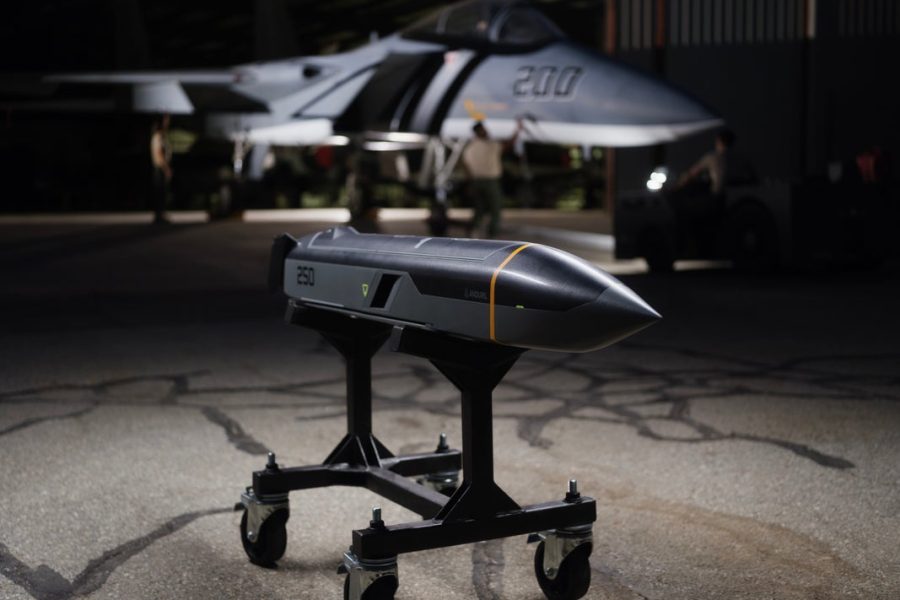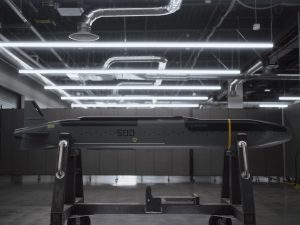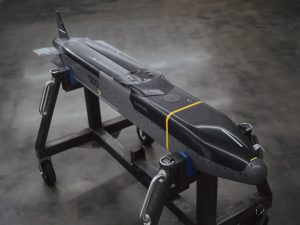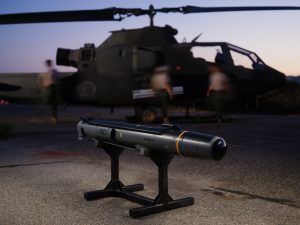Anduril Industries has revealed its “Barracuda” family of cruise missiles, intended to bulk up U.S. military stockpiles with a low-cost weapon that can be produced in large numbers by minimally trained labor with unspecialized tools.
The air-breathing weapons as yet have not been fitted with sensors, as customer needs are still undefined, but the weapons are in flight test, company officials told reporters Sept. 11. The Barracuda family is intended to be rapidly upgradable through software and an open-systems architecture.
The family of weapons comprises the Barracuda-100, -250, and -500.
The -500 is meant to be “cargo launched,” said Diem Salmon, Anduril vice president for air dominance and strike. This refers to the Air Force’s “Rapid Dragon” concept of launching pallets of cruise missiles from the back of a C-17 or C-130 transport, which has been tested using AGM-158 Joint Air-to-Surface Standoff Missiles (JASSMs).
It is also the kind of mission the Air Force and Defense Innovation Unit are exploring for their Enterprise Test Vehicle program, which got underway in June. Anduril is one of four competitors for the effort and is pitching the Barracuda-500, Salmon said. The other companies in the running are Integrated Solutions for Systems, Inc.; Leidos Dynetics; and Zone 5 Technologies. Salmon couldn’t comment on the ETV program progress.
The pallet-launched missiles “do not necessarily require aircraft integration,” she said. The -250, meanwhile, is designed to be carried internally on the F-35 and other platforms.
The Barracuda is “available in configurations offering 500+ nautical miles of range, 100+ pounds of payload capacity, 5 Gs of maneuverability, and more than 120 minutes of loitering time,” the company said in a press release.
“All Barracudas are compatible with a host of payloads and employment mechanisms, support a variety of different missions, and provide warfighters with an adaptable and upgradeable capability to counter evolving threats,” the company said.
Anduril is “targeting 30 percent less cost than systems that are comparable in performance,” Salmon said, but she did not offer comparisons with specific weapons. The company thinks that this level of savings can be achieved by reusing subsystems and easier manufacture with low-cost materials.
“So, rather than designing bespoke capabilities for each single weapon system, how do we make this simpler?” Salmon said. Open architectures is one solution, while designing the missile to be made by a factory worker with little specialized knowledge, using a small number of tools and parts, is another.
“A single Barracuda takes 50 percent less time to produce, requires 95 percent fewer tools, and 50 percent fewer parts than competing solutions on the market today,” the company said in press materials. “As a result, the Barracuda family of AAVs is 30 percent cheaper on average than other solutions, enabling affordable mass and cost-effective, large-scale employment.”
Anduril rolled out its “Arsenal” manufacturing plant idea in recent weeks, teasing announcements about weapons like Barracuda and its “Fury” Collaborative Combat Aircraft that would be made in the state-of-the art factory. It is proceeding from the assumption that the U.S. needs 10 times the number of precision weapons it now has in order to deter China and not “run out of stuff” to shoot in the first few weeks of a major conflict, Anduril chief strategy officer Chris Brose said.
“We’ve been at work on this for a few years,” Brose said. “This is a real system. It is already a part of real programs. It’s flying, and we’re really excited to finally be able to talk more about it publicly.
“The problem that we are seeking to solve here, I think, is a familiar one to many of you, which is America and our allies and partners do not have enough weapons. Period, full stop. And we are not capable of producing the volume of weapons that we’re going to need to establish deterrence against a peer competitor.”
Brose noted wargames that showed that the U.S. runs out of critical munitions in the first few weeks of a conflict.
“Then we struggle, or theoretically would struggle, for a period of years to replenish all the weapons that we expended,” he said. “And I think Ukraine has put that problem in high relief for the past few years on far simpler tactical weapon systems, to say nothing of the larger critical munitions that are going to be so essential for an INDOPACOM scenario.”
Salmon said it’s “unrealistic for us to believe that we will know exactly how many we need to produce 10 years from now,” and factories will have to be able to efficiently “ramp up, and sometimes, you have to ramp down.”
She added Anduril is aiming to reduce parts count, tooling, and complexity and “rely more on commercial components.” The entire work force as a whole won’t be “bespoke to just one single system,” she said.
Brose said every variant of Barracuda “leverages core subsystems which are reusable across the family of systems. These are systems that can be assembled with tools, literally that you probably have in your garage—screwdrivers, pliers, things of that sort, so it is not gated in terms of its producibility on highly specialized tooling, highly specialized manufacturing processes, highly specialized labor, none of which we’re ever going to have enough of. It’s been designed with the exact opposite approach, which is, I have to leverage commercial supply chains as much as possible. I have to make the weapon as simple to produce and as simple to assemble as possible.”
All three variants are flying now, Salmon said.
“These are things that we’re actively working on day-to-day,” she said.





